Euphorbia Lactea Cristata also known as Coral Cactus, Crested Elkhorn, and simply Crested Euphorbia, Euphorbia lactea ‘Cristata’ is a fan-shaped mutation of Euphorbia lactea. However, this plant’s strange appearance isn’t exactly what it seems as it’s common for Euphorbia lacteal ‘Cristata’ to be grafted onto Euphorbia neriifolia.
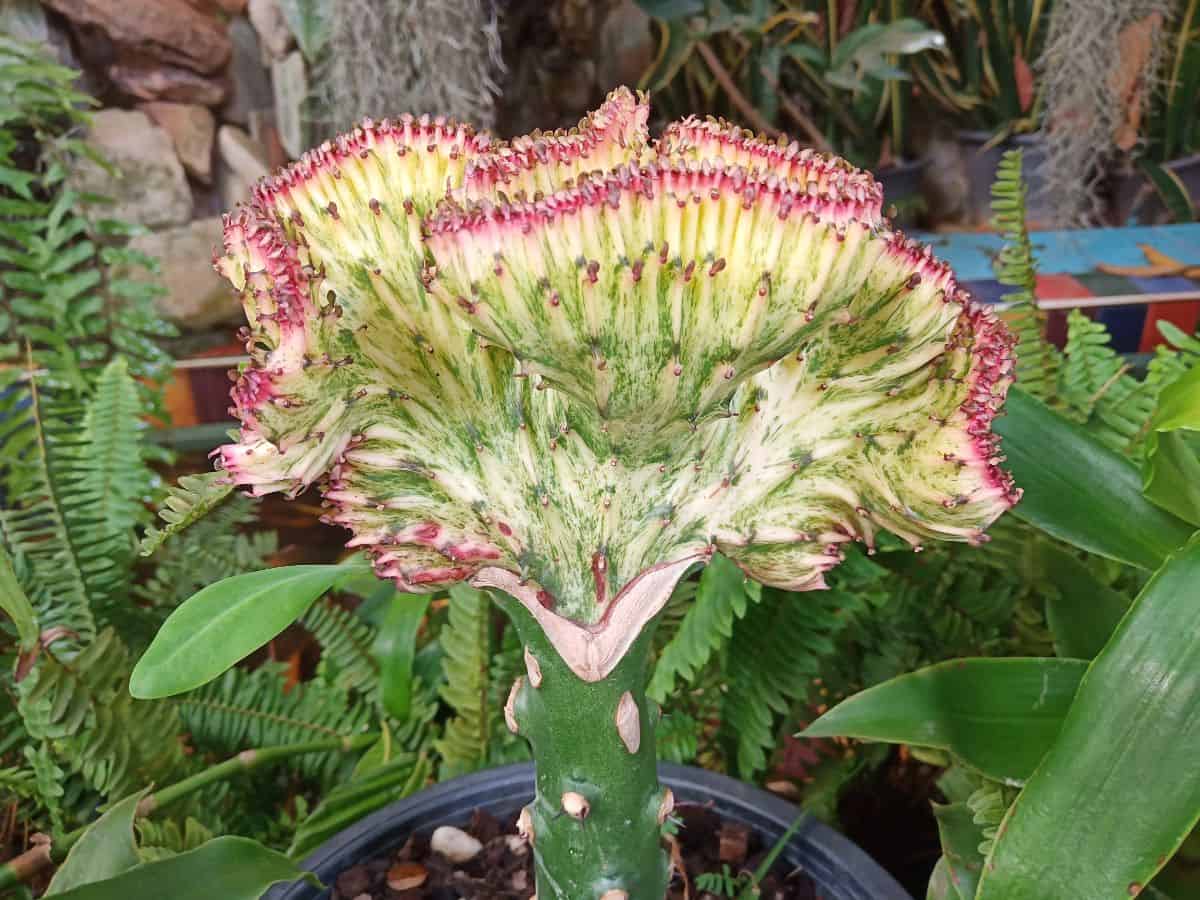
Description
| Name: | Euphorbia Lactea Cristata |
| Soil: | Succulent or cactus soil |
| Blooming: | Spring |
| Light: | Full sun to partial shade |
| Water: | When soil is dry below the surface |
| Propagation: | Cuttings |
Euphorbia lactea ‘Cristata’ is a unique-looking succulent with fan-shaped branches that grow in an almost undulating pattern. The stem and branches range in color from vibrant green to blue-gray or even silver. When stressed, the edges of the wavy branches can even develop a hue of pink.
These wavy succulents are popular among collectors of rare and unique succulents and for good reason. Euphorbia lactea are beautiful plants, but the crested variety is a sight to be seen.
It’s worth noting that although Euphorbia lactea ‘Cristata’ looks like a cactus, it’s technically just a succulent. Remember, all cacti are succulents, but not all succulents are cacti. The main difference in terms of this particular plant is that it doesn’t handle long periods of drought well.
Crested Euphorbia, like most Euphorbia, is also toxic if consumed by humans or animals, so it’s best to keep this plant away from children and pets. The exuding sap of E. lactea is also known to cause irritation if it contacts your skin, so be sure to handle it carefully or wear gloves.
Euphorbia lactea rarely blooms, if ever, so it’s unlikely you’re going to see your Crested Euphorbia produce flowers. If it does bloom, you can expect to see pink or purple flowers.
Care
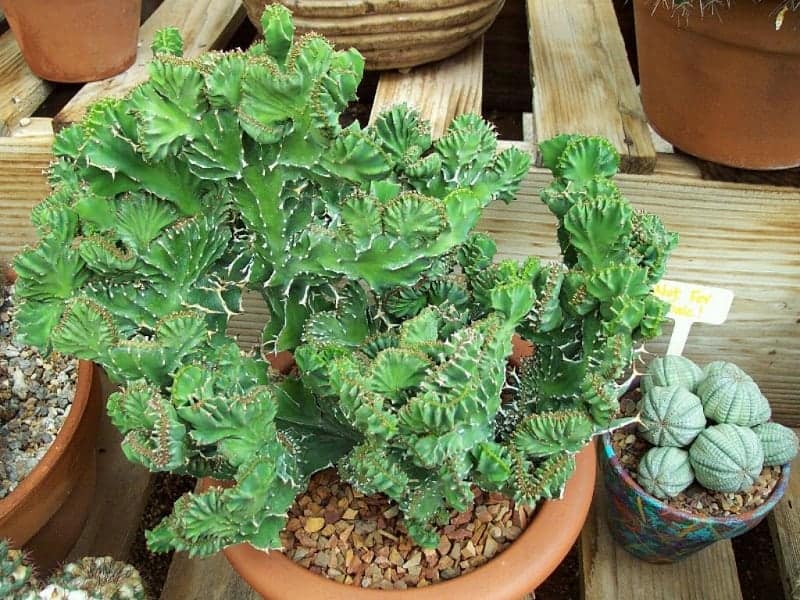
Buy it from:
Crested Euphorbia is a low-maintenance succulent that is ideal for beginner and experienced growers alike. They are slow-growing succulents, even if you can provide them with the right amount of sunshine and water.
These unique succulents are in high demand due to their exotic appearance, but fortunately, they don’t require any special care beyond that of the average succulent.
Water
Euphorbia lactea ‘Cristata’ should be watered anytime the soil is dry below the surface. During particularly hot or dry weather, this may mean watering your succulent as often as every week. Gardeners that live in more humid climates may find themselves watering their plants less frequently.
Crested Euphorbia prefer to be watered deeply but avoid allowing your plant to sit in standing water. Standing water or overly wet soil is a surefire way to encourage root rot to set in. Once the roots begin to rot, it’s likely that you won’t notice until it’s too late to save the plant.
You should also avoid allowing your Crested Euphorbia to dry out too much between watering. Despite its cactus-like appearance, this plant doesn’t tolerate long periods of drought.
Most gardeners experienced with caring for Crested Euphorbia recommend testing the soil prior to watering. You can use a soil moisture meter or your finger. Either way, insert the probe of the meter or your finger into the soil a few inches. If the meter reads as wet, or your finger feels damp, wait a few more days before watering.
Light
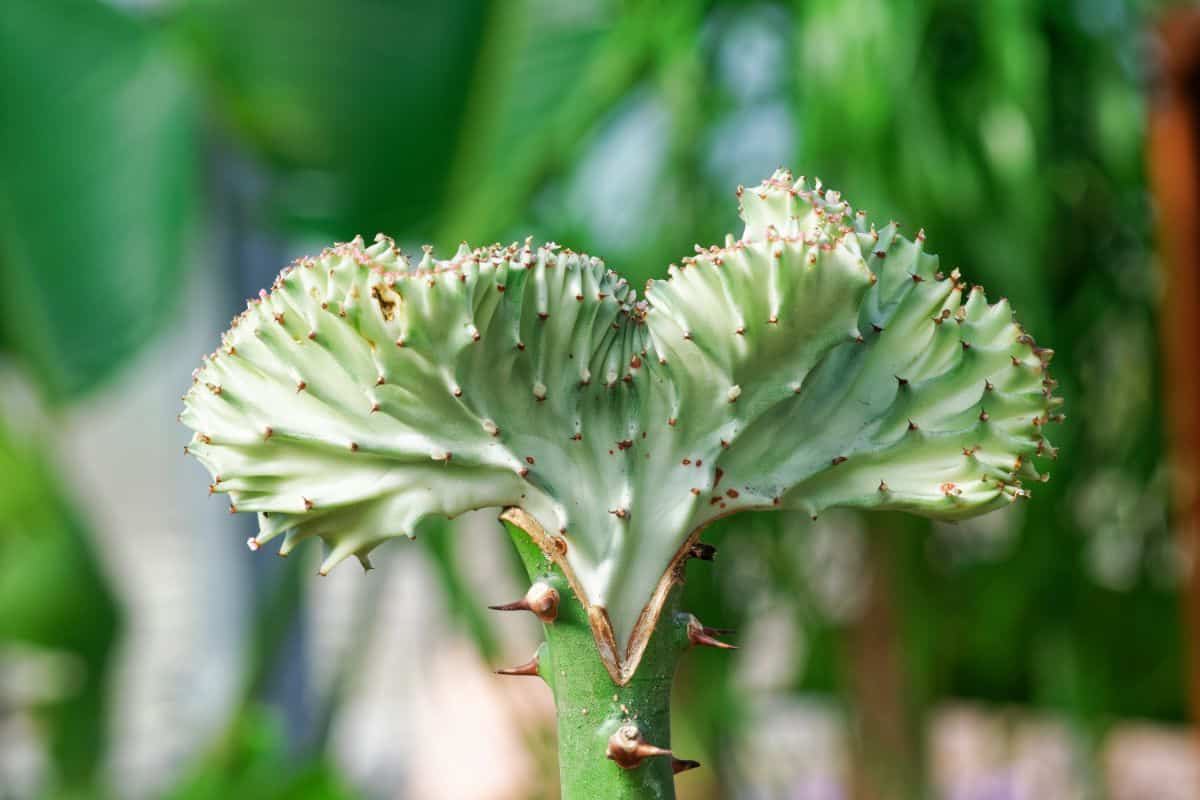
Crested Euphorbia prefers full sunlight, but they will do well in partial shade if necessary. They thrive when grown indoors, but can also be grown outdoors if the climate is warm enough.
When moving a Crested Euphorbia outdoors, it’s important to acclimate the plant slowly to prevent sunburn. Increasing the amount of light the plant receives each day over a period of several weeks will help the plant adapt without risking sunburn.
No products found.
Remember, sunburn damage cannot be fixed, so if you transition your Crested Euphorbia too quickly and it gets burned, you’re going to have to accept your plant’s new appearance.
When grown indoors, Crested Elkhorn does well in east or west-facing windows. Some south-facing windows may also be appropriate, but again, you’ll need to monitor for sunburn.
Euphorbia lactea does not do well in low light environments. If there is not enough light, this plant will lose its color and begin to develop a sickly appearance. However, if your home or office doesn’t have enough natural light to keep your plants healthy, Crested Euphorbia grows well under artificial grow lights.
Read Related Article: Suzanne’s Spurge (Euphorbia Suzannae) Succulent Care Guide
Temperature
Like most succulents, Crested Euphorbia prefers warm climates. They’re quite tolerant of high temperatures as well, just long as direct sunlight is avoided during times of extreme heat.
Crested Euphorbia does not tolerate freezing temperatures and must be protected from the cold. This is usually quite simple for plants grown indoors, but outdoor plants may need to be brought inside during colder weather.
If you plan on keeping your E. lactea outdoors, be prepared to bring it inside anytime temperatures begin to dip near 30 degrees Fahrenheit.
Soil
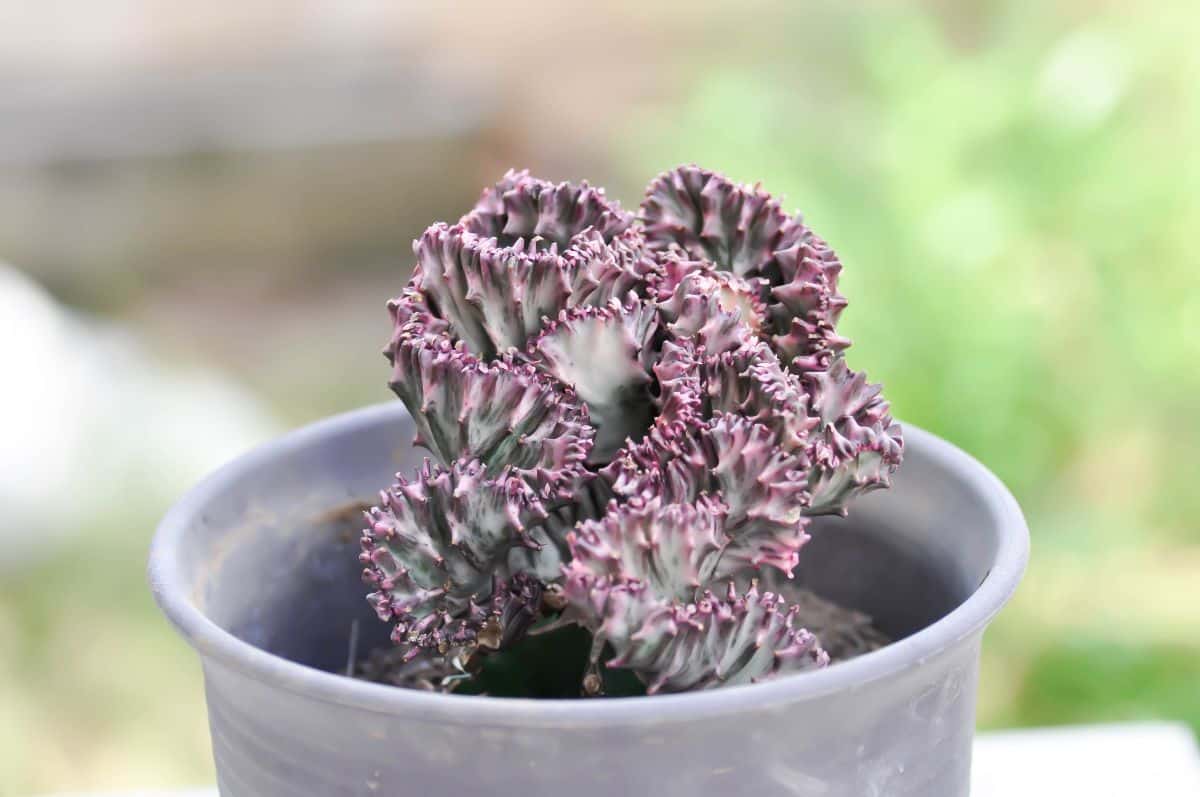
Crested Euphorbia do not have any specific soil requirements beyond the basics needs of most succulents. The soil should provide plenty of drainages to keep this plant healthy.
Like most succulents, it’s recommended to repot your new Coral Cactus after you bring it home from the nursery. While some nurseries use the proper soil required by succulents, the vast majority do not.
Repotting also gives you a chance to make sure the roots are healthy and there are no pests lurking below the soil surface.
If using a commercial soil mixture, most gardeners would recommend using one intended for use with succulents and cacti. Soils containing large particles such as gravel, coarse sand, or perlite are ideal. These large particles help to provide proper drainage and appropriate airflow to the roots.
In order to prevent root rot, you should avoid using soils that contain water-retaining ingredients such as peat moss or clay. Remember, Crested Euphorbia do not like wet soil. Too much moisture will lead to root rot, which may put your plant’s life at risk.
Once you have the right soil picked out, it’s important that you also choose a container that allows for proper drainage. Some gardeners choose pots based on their appearance rather than their drainage capabilities, and while this isn’t always a death sentence for succulents, it is risky.
There’s no sense in using well-draining soil if that excess moisture doesn’t have anywhere to go, so be sure to plant your Coral Cactus in a pot with at least one drainage hole in the bottom.
You also want to avoid putting rocks in the bottom of your pot to improve drainage. Unfortunately, this remedy doesn’t work as well as most people believe and can actually put your plants at a higher risk of developing root rot.
The reason for this is called a ‘perched water table’. Rather than allowing the water to drain down into the rocks, it stays perched above them in the soil. That means the excess moisture will be sitting closer to your Euphorbia’s roots.
Check Also: Euphorbia Enopla
Propagation
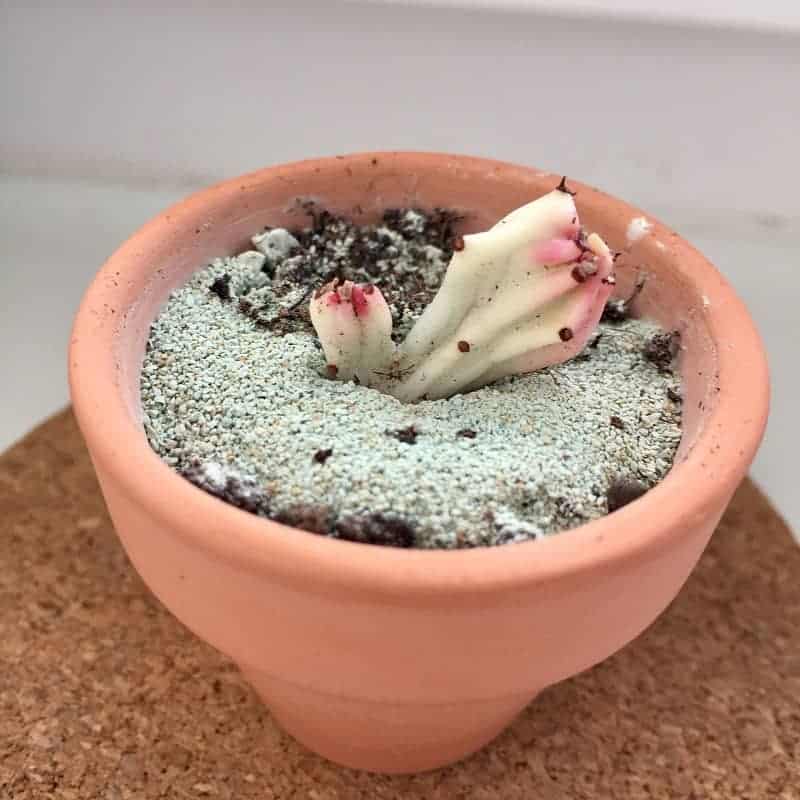
It’s not an easy task to propagate Euphorbia lacteal ‘Cristata’, but it possible for particularly determined growers. If you want to try your hand at propagating this unique plant, you must prepare yourself for the possibility of failure.
Realistically, the only way to propagate Crested Euphorbia is to graft a cutting onto a Euphorbia neriifolia or Euphorbia canariensis. Seeds are not a viable method for Crested Euphorbia propagation since they rarely flower and produce seeds.
If you’ve never grafted a plant before, the process isn’t particularly difficult and can be completed by gardeners of any experience level. It’s generally recommended to graft your cuttings during the summer, which is during the plant’s active growing season.
To reiterate, Euphorbia exudes a toxic sap when cut, so it’s highly recommended to wear protective gear such as gloves and safety goggles during the grafting process.
The sap of Euphorbia is an irritant that can cause burns on the skin and eyes if it comes into contact. In extreme cases, blindness can also occur if the sap gets into your eyes. If the sap does come into contact with your skin or eyes, it’s crucial to stop what you’re doing and wash your skin or eyes with water immediately.
Some people have more of a reaction than others, but it’s still best to proceed with caution. You should also cut your succulents somewhere that will prevent your children or pets from accidentally coming into contact with any sap.
Once you have your safety gear on, you can cut Euphorbia lactea into a triangular-shaped point. You should cut the plant you’re grafting it to into a complementary v-shape. The cuts should be about the same size so that they will fit together.
Whether you use a knife or pair of scissors or shears is up to you, but whatever tool you choose, make sure it’s sharp and clean. Dull and dirty cutting tools can damage your cuttings and potentially cause infections in the open wounds caused by cutting.
If you’re particularly worried about infection, you can also wipe your cutting blades down with rubbing alcohol prior to cutting. This ensures that your blades are sterile, so you won’t need to worry about passing disease or infection from one plant to another.
Once you’ve wedged your Crested Euphorbia onto the Euphorbia neriifolia or Euphorbia canariensis, you can secure the two plants together with twine or a strip of plastic wrap. Rubber bands also work well to keep the two plants in place.
Caring for your new graft is simple. Provide it with plenty of sunshine and warm temperatures and water it as you normally would. During this time, it’s best to avoid exposure to extreme temperatures or full sun.
For the first few weeks after grafting, it’s important to keep a close eye on your plants to make sure the process is going as planned. If you used clean and sharp cutting tools and secured the plants together, you should have little to worry about.
After several weeks, you can try removing the twine or wrap to see if the plants’ wounds have healed and joined them together. If they have healed, you can begin treating your new succulent as you would a mature Coral Cactus.
If the wounds haven’t yet healed, simply rewrap and check again in two or three weeks. In most cases, it shouldn’t take more than a month or two for the plants to heal and seal themselves together.
Read Related Topic: Sedum Album - A Care Guide
Common Pests and Problems
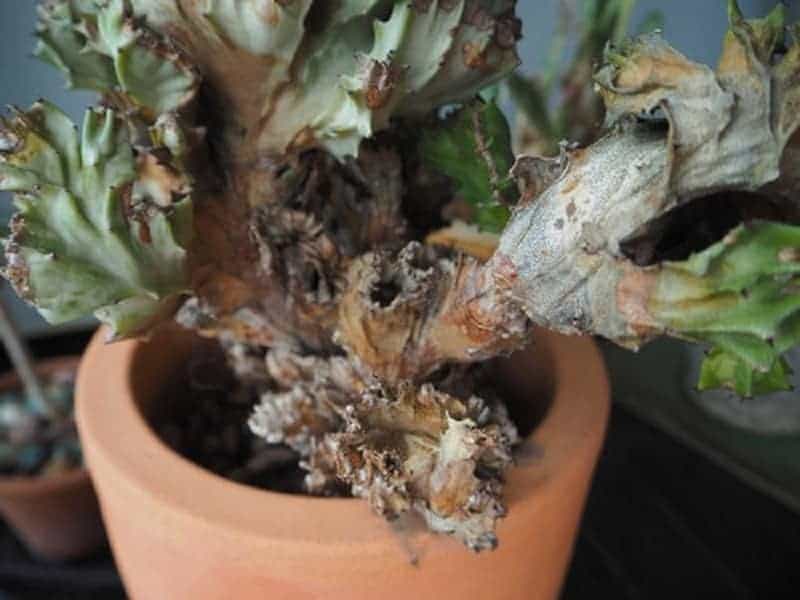
One of the most common problems affecting Crested Euphorbia is overwatering. It’s not always easy to find the right balance between not watering enough and watering too much, but you should always check the soil before you water.
Good plant hygiene will also contribute to a healthy plant, so always be sure to remove any dead plant material. Decaying plant material and overly wet soil set up the perfect environment for a variety of problems including pests, fungus, and bacteria.
Most gardeners recommend checking your plants every few days at least, even if you aren’t watering them that often. This gives you a chance to remove any dead leaves or branches from the soil, make sure your plants are getting enough sun and water, and check for any developing pest infestations.
Crested Euphorbia isn’t any more prone to pest infestations than any other type of succulent, but it’s still important to keep an eye out for creepy crawlies. Common pests that affect these plants include spider mites, mealy bugs, and fungus gnats.
If you can catch these pests during the early stages of their infestation, your plants are more likely to survive the encounter and the infestation will be easier to get rid of. Waiting until the pest population has exploded will result in a frustrating and time-consuming commitment to treating your plants for pests.
Since most species of pests have a relatively short life cycle, it doesn’t take long for their population to grow exponentially. Fortunately, that short life cycle will work to your advantage if you can catch the infestation early.
It’s also good practice to quarantine any new plants you bring into your home for a few weeks. That way, if they do contain any unwanted visitors, you’ll only have to treat your new plants rather than your entire collection.


